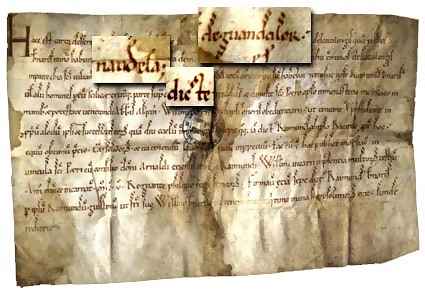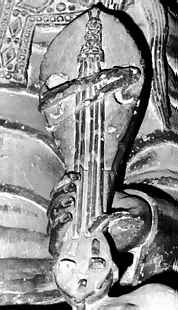Incredib'hole - hole sounds :
The "pre-moissagaise" musical iconography offers sound holes in simple holes and for the most of the time in semi-circles. No other site offers such a diversity.
The archeological study of the site has showed that the drawings seen in Moissac are not the product of restorations.
Two of the most astonishing ones are:
A 'C' with an interior notch like we can find on (violes de gambe) or on (vièle à roue ) ; and the most incredible one is S-shaped like we can see it differently stylised on the (quatuor) instruments , the jazz guitars , the dobros and other American mandolins.


Letter-shaped sound holes

By studying thoroughly the sound holes of Moissac , we can notice letters such as : A, B, C, D, E, S, and G (the letter B is lacking but four destroyed instruments are missing on the tympanum of Moissac).
These letters , the first ones of the alphabet , have been used for a long time to teach music (see Gui D?Arezzo and musical writing of antiquity) .
The master of Moissac would have finally chosen musical motifs to draw the sound holes of the instruments. Moreover , he used an outline of "virga retort" shape which is exclusively present in Moissac in the (neumatic) writing (it indicates a space between tonalities).
We can find many justifications to the presence of the "S".
The (neumatic) writing resorts to the "S" laying on the side to indicate a torculus , while a straight "S" indicates an oriscus. Yet it sometimes symbolises a sursum showing a small pitch of voice to the singer.
Finally, we have to say that the resort of the "F" as a hole sound-motif would have been a problem considering the morphology of the writing itself.
The "S" finally symbolises a semitonus that is to say a FA (F) in comparison with a MI (E) in the LA (A) scale. The sculptor of Moissac could have borrowed his idea of motifs to an author whose document we would not have received.
Using these motifs, I took care of linking them to the morphology of the writing used in the scriptorium of Moissac at the end of the 11th century and at the beginning of the 12th. There is no doubt that the outline of the sound holes of Moissac are close to the aesthetic of the period 1100/1105.

Master of sculpting and (luthier) in advance

The choice of these letters is yet motivated by the will to indicate the right place for his bridge.
In Moissac , all the bridges are perfectly centred.
Moreover, on one of the instruments, the sculptor has notched the side of the bridge in order to insist on the importance of the right positioning which guarantees a better precision ( after changing the strings for instance). We know that (les luthiers) would need several centuries to fix that principle.
The master of Moissac even informs us about the technical play of these instruments during his time.
The practice of the thumb used on the bass string (bourdon) is certified.
The shape of the ?pin-keys? and the fixation of the (cordier) perfectly represent today?s organs.
Nineteen one or two strings instruments are oblong-shaped.
No fret, no reported neck and the all suggests a woodblock construction, which seemed to impose the designation of rebeckes.(there is no guarantee about it, but I took into count recent works like the "Professeur Pierre bec?s philological study for instance").
3 instruments are shaped with 5 strings proposing 3 different assemblings of strings.
The sculpture indicates a reported neck, whereas the fret does not come over the (table d?harmonie).
Thus I thought that might have existed a generation of instruments which the body was dug into a block of soft wood , while the neck made into a harder wood would be thicker than the body.
While there is no (éclisse) , I used again the designation of rebeckes (even if the name only appeared in 1379 and "rebebe" in 1270? do not horses appear on wall paintings at least 3000 years before the name ?



